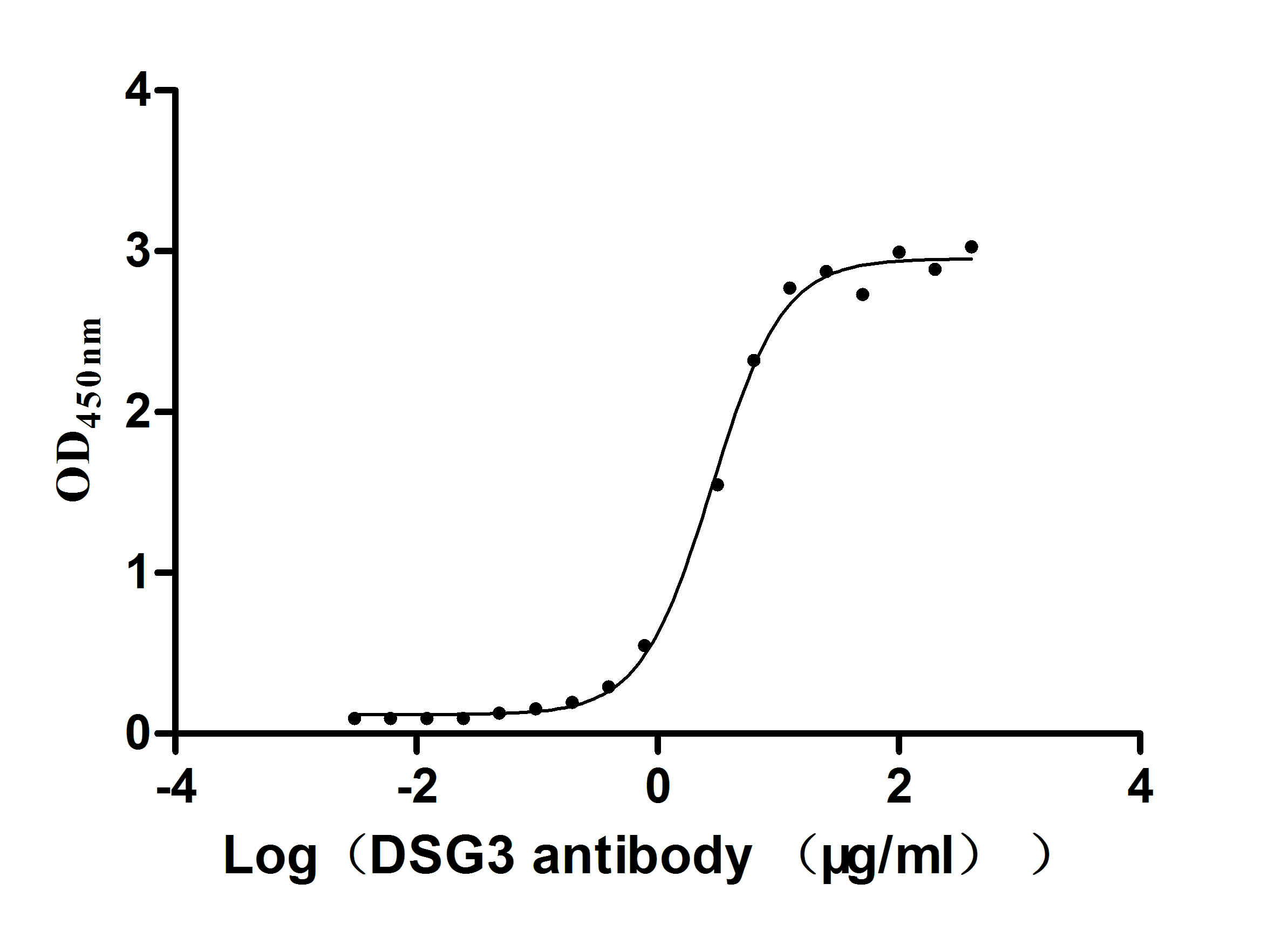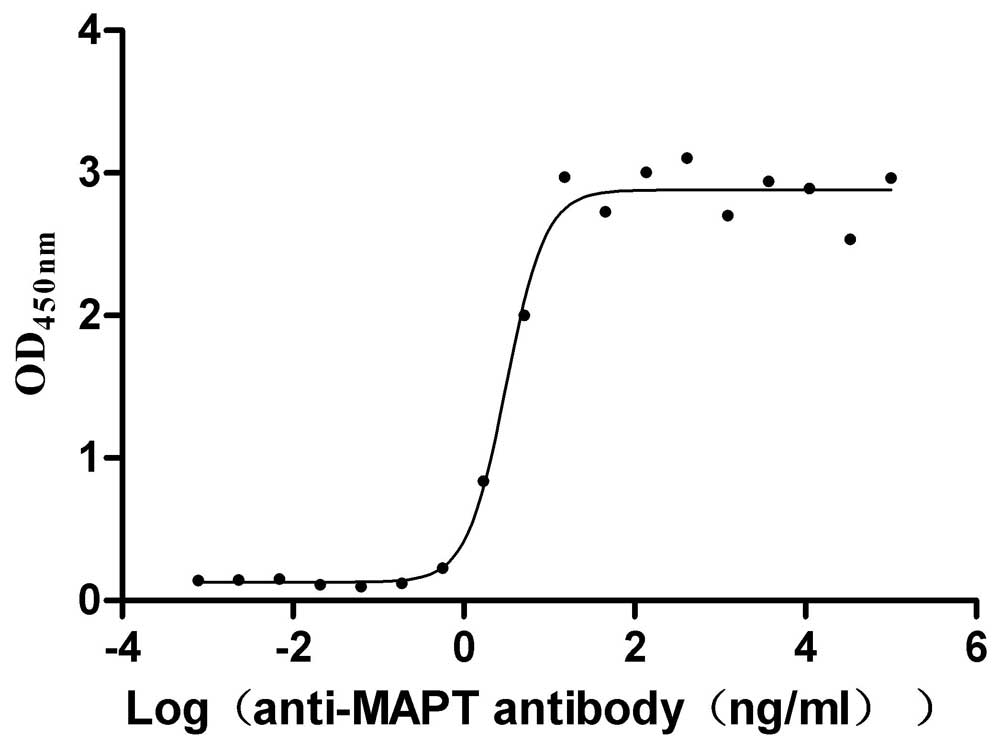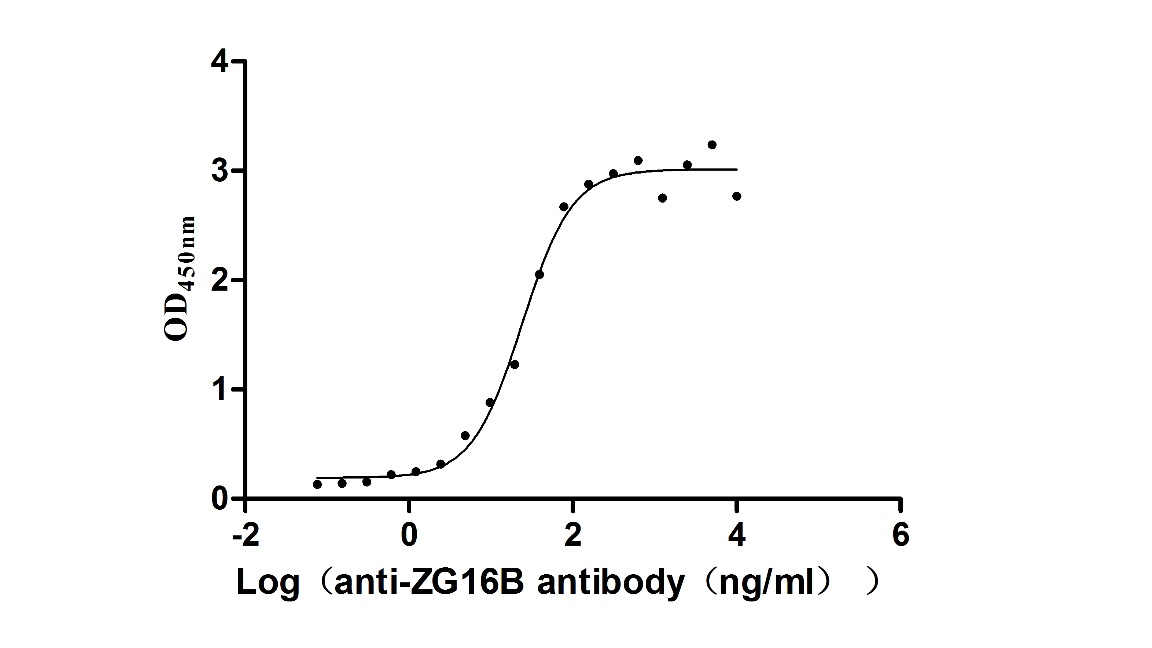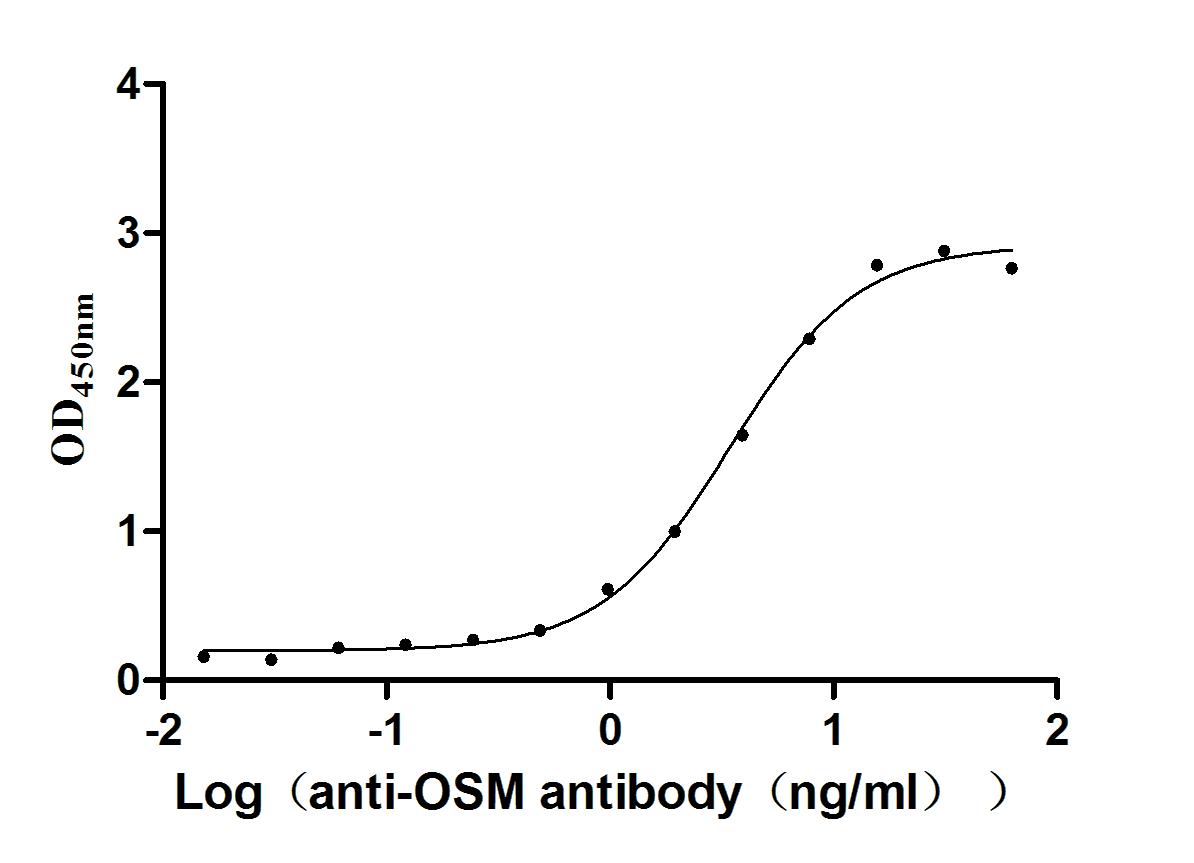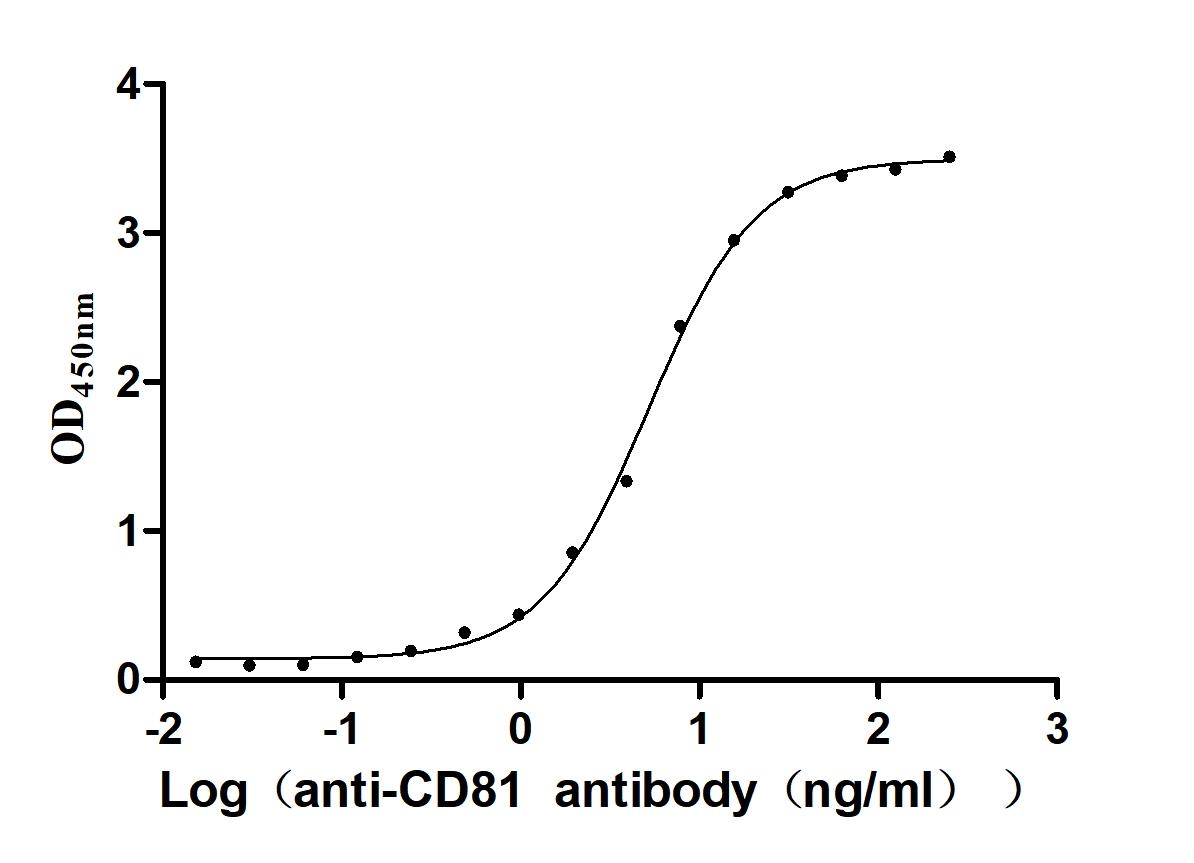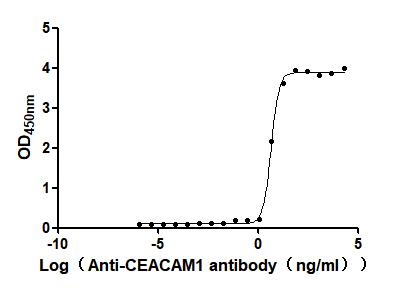Recombinant Human Heterogeneous nuclear ribonucleoprotein U (HNRNPU C1orf199 HNRPU SAFA U21.1)
-
中文名稱:
-
貨號:CSB-YP010615HU
-
規格:
-
來源:Yeast
-
其他:
-
中文名稱:
-
貨號:CSB-EP010615HU
-
規格:
-
來源:E.coli
-
其他:
-
中文名稱:
-
貨號:CSB-EP010615HU-B
-
規格:
-
來源:E.coli
-
共軛:Avi-tag Biotinylated
E. coli biotin ligase (BirA) is highly specific in covalently attaching biotin to the 15 amino acid AviTag peptide. This recombinant protein was biotinylated in vivo by AviTag-BirA technology, which method is BriA catalyzes amide linkage between the biotin and the specific lysine of the AviTag.
-
其他:
-
中文名稱:
-
貨號:CSB-BP010615HU
-
規格:
-
來源:Baculovirus
-
其他:
-
中文名稱:
-
貨號:CSB-MP010615HU
-
規格:
-
來源:Mammalian cell
-
其他:
產品詳情
-
純度:>85% (SDS-PAGE)
-
基因名:HNRPU
-
Uniprot No.:
-
別名:Heterogeneous nuclear ribonucleoprotein U; hnRNP U; GRIP120; Nuclear p120 ribonucleoprotein; Scaffold-attachment factor A; SAF-A; p120; pp120; HNRNPU C1orf199 HNRPU SAFA U21.1
-
種屬:Homo sapiens (Human)
-
蛋白標簽:Tag?type?will?be?determined?during?the?manufacturing?process.
The tag type will be determined during production process. If you have specified tag type, please tell us and we will develop the specified tag preferentially. -
產品提供形式:Liquid or Lyophilized powder
Note: We will preferentially ship the format that we have in stock, however, if you have any special requirement for the format, please remark your requirement when placing the order, we will prepare according to your demand. -
復溶:We recommend that this vial be briefly centrifuged prior to opening to bring the contents to the bottom. Please reconstitute protein in deionized sterile water to a concentration of 0.1-1.0 mg/mL.We recommend to add 5-50% of glycerol (final concentration) and aliquot for long-term storage at -20℃/-80℃. Our default final concentration of glycerol is 50%. Customers could use it as reference.
-
儲存條件:Store at -20°C/-80°C upon receipt, aliquoting is necessary for mutiple use. Avoid repeated freeze-thaw cycles.
-
保質期:The shelf life is related to many factors, storage state, buffer ingredients, storage temperature and the stability of the protein itself.
Generally, the shelf life of liquid form is 6 months at -20°C/-80°C. The shelf life of lyophilized form is 12 months at -20°C/-80°C. -
貨期:Delivery time may differ from different purchasing way or location, please kindly consult your local distributors for specific delivery time.Note: All of our proteins are default shipped with normal blue ice packs, if you request to ship with dry ice, please communicate with us in advance and extra fees will be charged.
-
注意事項:Repeated freezing and thawing is not recommended. Store working aliquots at 4°C for up to one week.
-
Datasheet :Please contact us to get it.
相關產品
靶點詳情
-
功能:DNA- and RNA-binding protein involved in several cellular processes such as nuclear chromatin organization, telomere-length regulation, transcription, mRNA alternative splicing and stability, Xist-mediated transcriptional silencing and mitotic cell progression. Plays a role in the regulation of interphase large-scale gene-rich chromatin organization through chromatin-associated RNAs (caRNAs) in a transcription-dependent manner, and thereby maintains genomic stability. Required for the localization of the long non-coding Xist RNA on the inactive chromosome X (Xi) and the subsequent initiation and maintenance of X-linked transcriptional gene silencing during X-inactivation. Plays a role as a RNA polymerase II (Pol II) holoenzyme transcription regulator. Promotes transcription initiation by direct association with the core-TFIIH basal transcription factor complex for the assembly of a functional pre-initiation complex with Pol II in a actin-dependent manner. Blocks Pol II transcription elongation activity by inhibiting the C-terminal domain (CTD) phosphorylation of Pol II and dissociates from Pol II pre-initiation complex prior to productive transcription elongation. Positively regulates CBX5-induced transcriptional gene silencing and retention of CBX5 in the nucleus. Negatively regulates glucocorticoid-mediated transcriptional activation. Key regulator of transcription initiation and elongation in embryonic stem cells upon leukemia inhibitory factor (LIF) signaling. Involved in the long non-coding RNA H19-mediated Pol II transcriptional repression. Participates in the circadian regulation of the core clock component ARNTL/BMAL1 transcription. Plays a role in the regulation of telomere length. Plays a role as a global pre-mRNA alternative splicing modulator by regulating U2 small nuclear ribonucleoprotein (snRNP) biogenesis. Plays a role in mRNA stability. Component of the CRD-mediated complex that promotes MYC mRNA stabilization. Enhances the expression of specific genes, such as tumor necrosis factor TNFA, by regulating mRNA stability, possibly through binding to the 3'-untranslated region (UTR). Plays a role in mitotic cell cycle regulation. Involved in the formation of stable mitotic spindle microtubules (MTs) attachment to kinetochore, spindle organization and chromosome congression. Phosphorylation at Ser-59 by PLK1 is required for chromosome alignement and segregation and progression through mitosis. Contributes also to the targeting of AURKA to mitotic spindle MTs. Binds to double- and single-stranded DNA and RNA, poly(A), poly(C) and poly(G) oligoribonucleotides. Binds to chromatin-associated RNAs (caRNAs). Associates with chromatin to scaffold/matrix attachment region (S/MAR) elements in a chromatin-associated RNAs (caRNAs)-dependent manner. Binds to the Xist RNA. Binds the long non-coding H19 RNA. Binds to SMN1/2 pre-mRNAs at G/U-rich regions. Binds to small nuclear RNAs (snRNAs). Binds to the 3'-UTR of TNFA mRNA. Binds (via RNA-binding RGG-box region) to the long non-coding Xist RNA; this binding is direct and bridges the Xist RNA and the inactive chromosome X (Xi). Also negatively regulates embryonic stem cell differentiation upon LIF signaling. Required for embryonic development. Binds to brown fat long non-coding RNA 1 (Blnc1); facilitates the recruitment of Blnc1 by ZBTB7B required to drive brown and beige fat development and thermogenesis.; (Microbial infection) Negatively regulates immunodeficiency virus type 1 (HIV-1) replication by preventing the accumulation of viral mRNA transcripts in the cytoplasm.
-
基因功能參考文獻:
- This series demonstrates common phenotypic features, including emerging dysmorphism, associated with heterozygous HNRNPU mutations. This allows us to define a novel neurodevelopmental syndrome, with a likely mechanism of haploinsufficiency PMID: 28944577
- SAF-A, in concert with Ku, temporally regulates base damage repair in irradiated cell genome. PMID: 27303920
- HNRPU deletion is associated with neurodevelopmental disorders. PMID: 28815871
- We broaden the clinical and mutational HNRNPU-associated spectrum, and demonstrate that heterozygous HNRNPU variants cause epilepsy, severe intellectual disability with striking speech impairment and variable central nervous system, cardiac, and renal anomalies. PMID: 28393272
- Results show that SAF-A and caRNAs form a dynamic, transcriptionally responsive chromatin mesh that organizes large-scale chromosome structures and protects the genome from instability. PMID: 28622508
- results confirm and refine the complex genotype-phenotype correlations existing in the 1qter microdeletion syndrome and define more precisely the neurodevelopmental phenotypes associated with genetic alterations of AKT3, ZBTB18 and HNRNPU in humans PMID: 28283832
- mutual regulatory mechanisms exist between PP4 and SAF-A. Interactions between PP4 and SAF-A played a role in prometaphase/metaphase transition. PMID: 27041735
- CENP-W interacts with hnRNPU and may contribute to kinetochore-microtubule attachment in mitotic cells. PMID: 26881882
- Nuclear TDP-43 becomes neurotoxic by escaping from the inhibitory regulation by hnRNP-U or hnRNP-A2. hnRNP-U inhibits TDP-43-mediated alterations in splicing of POLDIP3 mRNA. PMID: 25378556
- The results suggest that NCRNA00201 is not a major gene for microcephaly and corpus callosum abnormalities but is a good candidate for intellectual disability and seizures. PMID: 22678713
- both phosphorylation and dephosphorylation of SAF-A serine 59 by PLK1 and PP2A, respectively, are required for accurate and timely exit from mitosis. PMID: 25986610
- demonstrate that H19 inhibits RNA Pol II-mediated transcription by disrupting the hnRNP U-actin complex PMID: 23811339
- the hnRNP-U protection of cells after oxidative stress is largely due to enhancement of NEIL1-mediated repair. PMID: 22902625
- experimentally verified the targets heterogeneous nuclear ribonucleoprotein U, phosphatidylinositol-3-OH kinase, the WNK (with-no-lysine) kinase family and USP19 (ubiquitin-specific peptidase 19) as vulnerable nodes in the host cellular defence system against viruses PMID: 22810585
- These results suggest that HNRNPU, FAM36A, and NCRNA00201 are not major genes for microcephaly and corpus callosum abnormalities but are good candidates for intellectual disability (ID) and seizures. PMID: 22678713
- SAF-A interacts with BRG1 and both components are required for RNA Polymerase II Mediated Transcription PMID: 22162999
- hnRNP U is a regulator of SMN2 splicing. PMID: 22325991
- The nuclear scaffold protein (SAF-A) is a novel spindle regulator that plays an essential role in kinetochore-microtubules (MT)attachment and mitotic spindle organization. PMID: 21242313
- Single nucleotide polymorphism in HNRPU gene is associated with speech delay, seizures and variable corpus callosum thickness. PMID: 20382278
- hnRNP U/SAF-A/SP120 regulates the enzyme DNA Topoisomerase IIbeta in dual ways PMID: 20554522
- Ash2l and Saf-A are recruited to the inactive X chromosome at the onset of stable X inactivation. PMID: 20150277
- hnRNP-U engages a highly neddlylated active SCF beta-TRCP which dissociates in the presence of a high-affinity substrate, resulting in the ubiquitination of the latter. PMID: 11850407
- Scaffold/matrix attachment region elements interact with a p300-scaffold attachment factor A complex and are bound by acetylated nucleosomes. PMID: 11909954
- Heterogeneous nuclear ribonuclear protein U associates with YAP and regulates its co-activation of Bax transcription PMID: 15096513
- PRMT1 has a role in arginine methylation of SAF-A PMID: 15364944
- The results suggest that HIV-1 requires machinery for the nuclear export of viral mRNAs that can be specifically blocked by an interfering gene. PMID: 16916646
- These findings increase our knowledge of how WT1 exerts its transcriptional regulatory role and suggests that hnRNP-U may be a candidate Wilms' tumour gene at 1q44. PMID: 16924231
- the spatial proximities among a constellation of functionally related sites that are found within euchromatic regions of the cell nucleus including: HP1gamma, RNA polymerase II, matrin 3, and SAF-A sites PMID: 18618731
- The histone acetyltransferase (HAT) PCAF associates with actin and hnRNP U. PMID: 18710935
- hnRNP-U is phosphorylated at Ser59 by DNA-PK in vitro and in cells in response to DNA double-strand breaks. PMID: 19351595
- Data demonstrate that hnRNP U is involved in HP1alpha function, shedding new light on the mode of action of HP1alpha and on the function of hnRNP U. PMID: 19617346
顯示更多
收起更多
-
相關疾病:Epileptic encephalopathy, early infantile, 54 (EIEE54)
-
亞細胞定位:Nucleus. Nucleus matrix. Chromosome. Nucleus speckle. Cytoplasm, cytoskeleton, microtubule organizing center, centrosome. Chromosome, centromere, kinetochore. Cytoplasm, cytoskeleton, spindle. Cytoplasm, cytoskeleton, spindle pole. Midbody. Cytoplasm. Cell surface. Cytoplasmic granule.
-
組織特異性:Widely expressed.
-
數據庫鏈接:
Most popular with customers
-
Recombinant Mouse Desmoglein-3 (Dsg3), partial (Active)
Express system: Mammalian cell
Species: Mus musculus (Mouse)
-
Recombinant Macaca mulatta Microtubule-associated protein tau (MAPT) (Active)
Express system: Mammalian cell
Species: Macaca mulatta (Rhesus macaque)
-
Recombinant Macaca fascicularis zymogen granule protein 16 homolog B (ZG16B) (Active)
Express system: Mammalian cell
Species: Macaca fascicularis (Crab-eating macaque) (Cynomolgus monkey)
-
Recombinant Human Oncostatin-M (OSM), partial (Active)
Express system: Mammalian cell
Species: Homo sapiens (Human)
-
Recombinant Human CD81 antigen (CD81), partial (Active)
Express system: Mammalian cell
Species: Homo sapiens (Human)
-
Express system: Mammalian cell
Species: Homo sapiens (Human)


